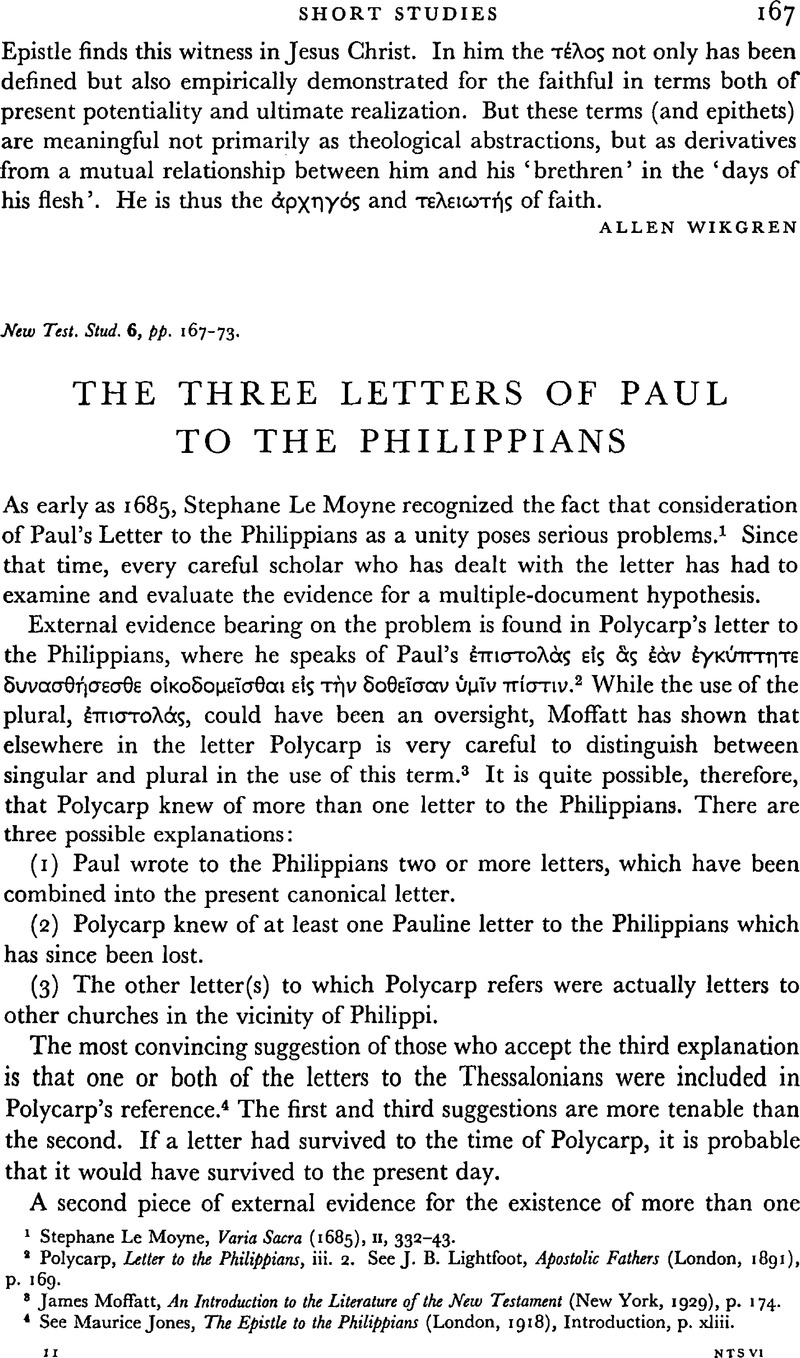Article contents
The Three Letters of Paul to the Philippians
Published online by Cambridge University Press: 05 February 2009
Abstract

- Type
- Short Studies
- Information
- Copyright
- Copyright © Cambridge University Press 1960
References
1 Moyne, Stephane Le, Varia Sacra (1685), ii, 332–43.Google Scholar
2 Polycarp, Letter to the Philippians, iii. 2. See Lightfoot, J. B., Apostolic Fathers (London, 1891), p. 169.Google Scholar
3 Moffatt, James, An Introduction to the Literature of the New Testament (New York, 1929), p. 174.Google Scholar
4 See Jones, Maurice, The Epistle to the Philippians (London, 1918), Introduction, p. xliii.Google Scholar
1 See Moffatt, , Introduction to N. T. p. 174.Google Scholar
2 Goguel, Maurice, Introduction au Nouveau Testament (Paris, 1925), IV, part I, 402–3.Google Scholar
3 Syncellus, Georgius, Chronographia, see Corpus Scriptorum Historiae Byzantine, ed. Dindorf, x, 651.![]() Google Scholar
Google Scholar
4 Cf. Michael, J. H., The Epistle of Paul to the Philippians (New York, 1927), Introduction, section 7.Google Scholar
5 Schrader, Karl, Der Apostel Paulus (Leipzig, 1835), v, 233.Google Scholar
6 Volter, D., Paulus und Seine Briefe (Strassburg, 1905), pp. 319 ff.Google Scholar
7 Paulus, , Heidelberg Jahrbucher (1812), pp. 702 ff. Cited by Moffatt, op. cit. p. 175.Google Scholar
8 E.g. Ewald, Paul, Der Brief des Paulus an die Philipper (Leipzig, 1908), pp. 23 and 150Google Scholar ff. Stephane Le Moyne, loc. cit. Hausrath, A., A History of N. T. Times (London, 1895), p. 162Google Scholar, footnote 2. Bacon, B. J., The Story of St Paul (Boston, 1904), pp. 367 ff.Google ScholarLake, K., The Expositor (London), series 8, vol. vii, pp. 487 ff.Google Scholar
9 Symes's article is exceedingly brief. There is no real proof brought forth to support his statements. He feels that the letters we have are in fragments, and that at least two letters have been lost. Much of his work, especially the precise dating of the material, seems to be too much supposition and too little fact.
1 Cf. Moffatt, , Introduction to N.T. p. 175, footnote 1: ‘Each of the letters postulated by the partition theories must have been mutilated.’Google Scholar
2 The question of the location of the prison in which this letter was written has been debated for years without any definite proof for any theory. The writer feels that a Roman imprisonment best explains many of the references in the letter. As Knox, John says in Chapters in a Life of Paul (New York–Nashville, 1950), p. 87Google Scholar: ‘There is nothing decisive against the usual date (of Philippians), during the Roman imprisonment described at the very end of Acts.’
1 Cf. Acts xxiv. 15.
2 Cf. Phil. ii. 2 with ii. 3. This statement seems to refer to the Jews, rather than to Jewish Christians. See Bacon, B. J., St Paul, pp. 368 ff.Google Scholar
3 Cf. Moffatt, Goguel, et al.
4 ‘What then? Only that in every way, whether in pretence or in truth, Christ is preached, and because of that I rejoice.’ Phil. i. 18.
5 Typical of the O.T. attitude toward dogs is the statement in Deut. xxiii. 18 that not even the price of a dog can be used as an offering in the Temple.
6 E.g. a dog's howling means that the angel of death is in a town (Baba Kamma 60b); dogs eat the flesh of corpses (Zabim, chapter 2, Mishna 3; Oholoth, chapter II, Mishna 7). None of the Talmudic references to dogs is complimentary.
1 M. S., and Miller, J. L., Encyclopedia of Bible Life (New York, 1944), p. 36.Google Scholar
2 Phil. i. 1 to ii. 30, and Phil. iii. i–iv. 9.
3 On the use of χαιρετε as ‘farewell’ see Bauer, Walter, A Greek–English Lexicon of the N.T., translated by Arndt, and Gingrich, (Chicago, 1957), p. 882.Google Scholar
4 It has been suggested that the σύνʒυγε might be Epaphroditus. It is doubtful, however, whether he would have gained enough power in the lifetime of Paul to be the leader of the church, to whom Paul would address such a request. The suggestion that σύνʒυγε was a proper name is not convincing. It is not likely that a person of such importance would be entirely unheard of, outside of this one reference. The word is never used as a proper name elsewhere.
5 Cf. Phil. i. 24 and 25.
6 This testament pattern is very ancient, and has remained in Jewish usage to the present day. It takes its form from the blessings of Moses (Deut. xxxii and xxxiii) and Joshua (Josh. xxiii and xxiv) to their posterity. Lods, Adolphe (Histoire de la Littérature Hébraïque et Juive (Paris, 1950), pp. 818 ff.)Google Scholar in analysing the Testaments of the Twelve Patriarchs (see The Apocrypha and Pseudepigrapha of the O.T., ed. R. H. Charles, 11, 282–367) finds three essential elements in each of the Testaments. (1) Some autobiographical information, concerning the moral life of the patriarch in question. (2) Moral exhortations, urging the children to avoid any faults confessed by their father, or, in case he was without sin (e.g. Benjamin, Joseph, Zebulun, Issachar, and Levi), urging them to imitate his behaviour. (3) A short prediction of the future destiny of the tribe. Each of the elements can be found in Phil. iii. 4–iv. 9: (I) Phil. iii. 4–iii. 14; (2) Phil. iii. 15–iv. 5a; (3) Phil. iv. 5b–iv. 9.
1 See footnote 6, p. 171.
2 See footnote 3, p. 171.
3 See Rev. i. 3 and xxii. 10 for the use of έγγ⋯ς in an eschatological setting.
1 Not even the long autograph at the end of Galatians.
2 Cf. the Corinthian correspondence. See also the reconstruction of this general process by K. Lake (see footnote 8, p. 168).
- 4
- Cited by




